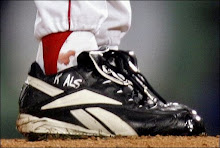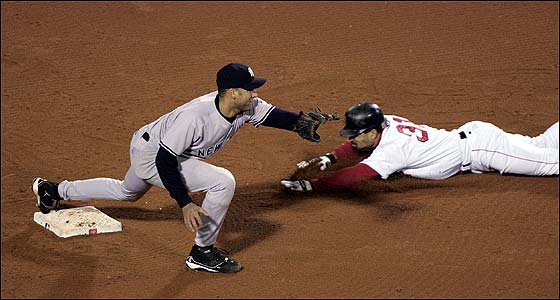
The Boston Red Sox could have been considered the definite team of the decade. Over the course of the new millennium, the Red Sox have won two World Series titles, one American League East championship and qualified for a postseason berth six out of ten years. In an ever-changing decade, the Sawx are the only team to win multiple championships so far--the Phillies, Angels and Yankees have above-average chances at completing this feat as well.
There once was a dark era in Boston when winning wasn't taken for granted--only because winning the WS happened about as much as the Houston Texans making the playoffs. A sense of entitlement has settled all over the homes of Red Sox Nation. Many of us avid and passionate Red Sox fans still exist, but the lust for winning and the desire for this to be the year that ends all long-standing curses has ceased to exist. Moreover, it is becoming a trendy and fashionable statement to like the Sox. It is no longer about how the team plays, but if the team remains popular. The Red Sox have not won the World Series since 2007; in the past two years, the Old Towne Team has lost Game 7 of the 2008 ALCS to the once-mighty Rays and received a beat down from the sumo-like Angels. This will be the time in which we separate the true fans from the bandwagon fools. I wonder how many Red Sox jerseys will turn into pinstriped hats over the winter.
The 2009 Red Sox couldn't have been more confusing. For the first time in the Theo Epstein era, we lacked an identity. At the start of our season, we had a total of 8 starting pitchers that made up one of the deepest pitching staffs in the history of baseball (Beckett, Lester, Matsuzaka, Wakefield, Penny, Smoltz, Buchholz and Bowden). This was the strength of our club; to reach our ultimate goal, another World Series championship, our starting pitching was going to have to perform on a consistent basis-- something this Red Sox team hadn't accomplished since our last WS title in '07. At the end of the season, the starting rotation was as follows: Jon Lester (new ace), Josh Beckett (old ace), Clay Buchholz, a rejuvenated Dasiuke Matsuzaka and a trio of pitchers in Tim Wakefield, Paul Byrd (?!) and Michael Bowden.
One of the American League's most offensively talented teams lacked any kind of fire power and did not strike fear into opposing pitchers' minds as it had done for the past six seasons-- even with the acquisition of Victor Martinez. Players like David Ortiz, Mike Lowell and Jason Varitek continued their rabid declines. Key offensive players such as Dustin Pedroia and Kevin Youkilis could not maintain their level of play from the prior campaign, but yet still posted significant numbers albeit inconsistent at times.
The Red Sox expected--and received--a high level of play from their outfield. Jacoby Ellsbury showed the Fenway Faithful that he can be a reliable and consistent player in the Major Leagues. Although Ellsbury stole 70 bases this year-- a new Red Sox single season record--his defense negated the thefts after posting a UZR (defensive metric) of -13.5. Jason Bay posted Manny Ramirez-like numbers in 2009 when he hit 36 bombs and drove in 119 runners. Although Bay posted high power numbers, his average dipped to .267. While his UZR improved from 2008 (-18.4) to 2009 (-13.9), Bay negated some of his offensive prowess-- just like Ellsbury. In 2009, the Red Sox received great play from JD Drew in RF. Drew contained the second-highest OPS for AL outfielders in the second half of the season. Drew hit close to .280 at .279 while hitting over 20 homeruns for his second time in a Sox uniform. Drew--unlike the other two Red Sox outfielders-- played outstanding defense in a tricky Fenway Park right field. Drew posted a customary 9.7 UZR, which is terrific. All in all, the Red Sox outfielders hit very well, but it didn't matter much because of their horrible play in CF and LF.
This organization and front office has proven that they can nadle the upper elite organizations of the league. This same club, however, has proved to be a bit to conservative when it comes to acquiring the talent that takes to win. The Red Sox identify quality players that fit our style of play. They need not spend on free agent pitchers who demand top-dollar contracts. What the organization values the most--and it values it too much sometimes--is young pitching. The organization also sets a number on a player and they do not cross the proverbial line.
The Mark Teixeira negotiations are a great example. It was reported that the All- Star first baseman demanded an eight-year, 176 million dollar contract. It was also reported that the Red Sox offered 168 million. Teixeira would put his John Hancock on the line had the Sox ponied up a mere eight million dollars more. Long story short, we lost at the last minute when the New York Yankees jumped into the negotiations and brought him to New York for 180 million. The Yankees spent the money and, along with other top free-agent acquisitions, won 103 regular season games and now face the Los Angeles Angels of Anaheim for the American League Pennant.
After losing out on Teixeira, the organization smartly made short-term, high-upside signings. John Smoltz, Brad Penny, Rocco Baldelli, Takashi Saito and Mark Kotsay assumed key roles for the team, but they were obviously Plan B after losing out on Mr. Teixeira.
The Red Sox, after losing Game 7 of the 2008 AlCS, recognized that they needed an impact bat for their weak middle-of-the-order after they dealt a legendary hitter in Manny ramirez away to the Dodgers of that same year. Entering 2009, questions about the potency of the offense returned and lingered throughout the year. The acquistion of Victor Martinez was a step in the right direction towards acquiring impact hitting while dealing away young and affordable pitching.
Earlier this month, we were exposed for the second straight year in October. We scored seven runs in 27 innings of playoff baseball.
If the 2010 version of the Red Sox want to return to glory, ugrades need to occur. Here is my blueprint:
Offense:
- Victor Martinez needs to be the everyday catcher
- Kevin Youkilis needs to hit behind Dustin Pedroia (3rd)
- Matt Holliday, and not Jason Bay, needs to be manning left field next year (UZR efficiency)
- Mike Lowell needs to be either platooned with David Ortiz as the DH or traded away
- David Ortiz needs to return to being Big Papi
- A reliable and productive shortstop needs to be acquired (NOT Marco Scutaro--Type A FA would cost two draft picks and he is not worth that)
- An impact bat must be traded for: Adrian Gonzalez or Prince Fielder
Lineup:
1. Jacoby Ellsbury---CF
2. Dustin Pedroia---2B
3. Kevin Youkilis---3B
4. Prince Fielder---1B
5. Victor Martinez---C
6. Matt Holliday---LF
7. David Ortiz/ Mike Lowell---DH
8. Miguel Tejada---SS
9, JD Drew---RF
Pitching:
- Cannot trade Clay Buchholz
- Cannot trade Daniel Bard
- Sign a low-rish, high-reward type pitcher (Harden, Bedard, Sheets or Duchsherer)
- Retain Billy Wagner
Rotation:
1. LHP---Jon Lester
2. RHP---Josh Beckett
3. RHP---Clay Buchholz
4. RHP---Daisuke Matsuzaka
5. LHP/RHP---Erik Bedard/ Rich Harden
Bullpen:
CL- Jonathan Papelbon
SU- Billy Wagner
SU- Daniel Bard
MR- Hideki Okajima
MR- Manny Delcarmen
MR- Takashi Saito
MR- Brandon Lyon
It is unwise to destroy or blow-up championship teams. The 2009 Red Sox team looked too much like the 2008 and 2006 version to remain intact. Aging veterans like Jason Varitek, David Ortiz and Mike Lowell should be retained, but a new influx of primed talent should be injected into this team if another deep October run is expected.
As Tony Massarotti wrote about this year's version of the Red Sox , "Good enough to make the playoffs, flawed enough to fall short of a championship."


No comments:
Post a Comment